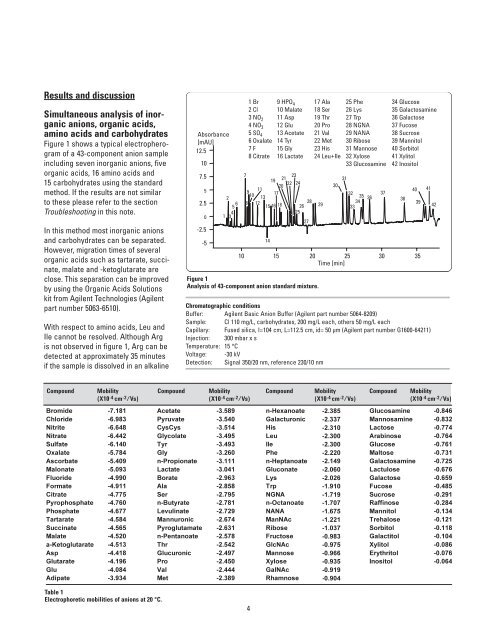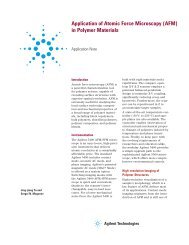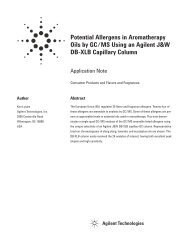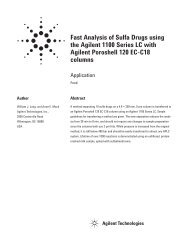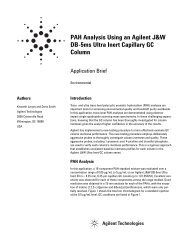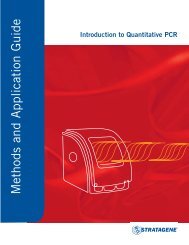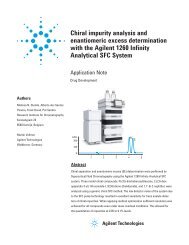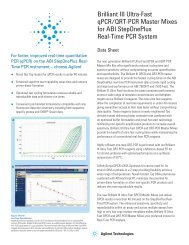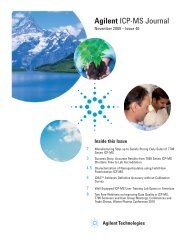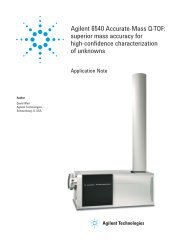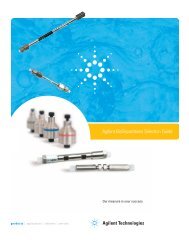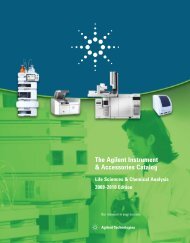Simultaneous analysis of inorganic anions, organic acids, amino ...
Simultaneous analysis of inorganic anions, organic acids, amino ...
Simultaneous analysis of inorganic anions, organic acids, amino ...
You also want an ePaper? Increase the reach of your titles
YUMPU automatically turns print PDFs into web optimized ePapers that Google loves.
Results and discussion<br />
<strong>Simultaneous</strong> <strong>analysis</strong> <strong>of</strong> <strong>in<strong>organic</strong></strong><br />
<strong>anions</strong>, <strong>organic</strong> <strong>acids</strong>,<br />
<strong>amino</strong> <strong>acids</strong> and carbohydrates<br />
Figure 1 shows a typical electropherogram<br />
<strong>of</strong> a 43-component anion sample<br />
including seven <strong>in<strong>organic</strong></strong> <strong>anions</strong>, five<br />
<strong>organic</strong> <strong>acids</strong>, 16 <strong>amino</strong> <strong>acids</strong> and<br />
15 carbohydrates using the standard<br />
method. If the results are not similar<br />
to these please refer to the section<br />
Troubleshooting in this note.<br />
In this method most <strong>in<strong>organic</strong></strong> <strong>anions</strong><br />
and carbohydrates can be separated.<br />
However, migration times <strong>of</strong> several<br />
<strong>organic</strong> <strong>acids</strong> such as tartarate, succinate,<br />
malate and -ketoglutarate are<br />
close. This separation can be improved<br />
by using the Organic Acids Solutions<br />
kit from Agilent Technologies (Agilent<br />
part number 5063-6510).<br />
With respect to <strong>amino</strong> <strong>acids</strong>, Leu and<br />
Ile cannot be resolved. Although Arg<br />
is not observed in figure 1, Arg can be<br />
detected at approximately 35 minutes<br />
if the sample is dissolved in an alkaline<br />
Absorbance<br />
[mAU]<br />
12.5<br />
10<br />
7.5<br />
5<br />
2.5<br />
0<br />
-2.5<br />
-5<br />
1 Br 9 HPO 4 17 Ala 25 Phe 34 Glucose<br />
2 Cl 10 Malate 18 Ser 26 Lys 35 Galactosamine<br />
3 NO 2 11 Asp 19 Thr 27 Trp 36 Galactose<br />
4 NO 3 12 Glu 20 Pro 28 NGNA 37 Fucose<br />
5 SO 4 13 Acetate 21 Val 29 NANA 38 Sucrose<br />
6 Oxalate 14 Tyr 22 Met 30 Ribose 39 Mannitol<br />
7 F 15 Gly 23 His 31 Mannose 40 Sorbitol<br />
8 Citrate 16 Lactate 24 Leu+Ile 32 Xylose 41 Xylitol<br />
33 Glucosamine 42 Inositol<br />
7 23<br />
19<br />
21<br />
22 24<br />
20<br />
11<br />
9 10<br />
17<br />
2<br />
13<br />
5 6 8 12<br />
28<br />
15 16 18 26<br />
1 3 4 25<br />
27<br />
10 15 20 25 30 35<br />
Time [min]<br />
Figure 1<br />
Analysis <strong>of</strong> 43-component anion standard mixture.<br />
14<br />
29<br />
30<br />
31<br />
32<br />
35 36<br />
37<br />
34<br />
33<br />
Chromatographic conditions<br />
Buffer: Agilent Basic Anion Buffer (Agilent part number 5064-8209)<br />
Sample: Cl 110 mg/L, carbohydrates, 200 mg/L each, others 50 mg/L each<br />
Capillary: Fused silica, I=104 cm, L=112.5 cm, id= 50 µm (Agilent part number G1600-64211)<br />
Injection: 300 mbar x s<br />
Temperature: 15 °C<br />
Voltage: -30 kV<br />
Detection: Signal 350/20 nm, reference 230/10 nm<br />
38<br />
40<br />
39<br />
41<br />
42<br />
Compound<br />
Mobility<br />
(X10 -4 cm -2 /Vs)<br />
Compound<br />
Mobility<br />
(X10 -4 cm -2 /Vs)<br />
Compound<br />
Mobility<br />
(X10 -4 cm -2 /Vs)<br />
Compound<br />
Mobility<br />
(X10 -4 cm -2 /Vs)<br />
Table 1<br />
Electrophoretic mobilities <strong>of</strong> <strong>anions</strong> at 20 °C.<br />
4


